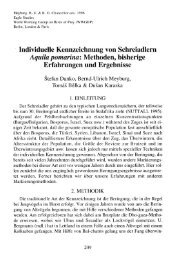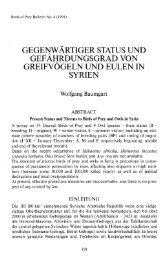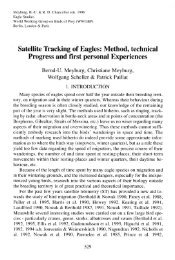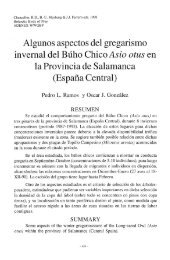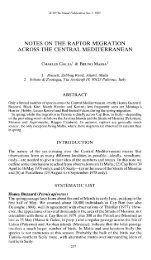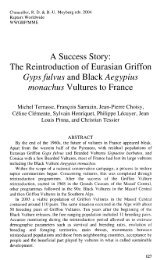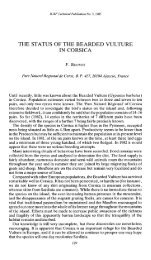Action Plan for the Recovery and Conservation of Vultures on the ...
Action Plan for the Recovery and Conservation of Vultures on the ...
Action Plan for the Recovery and Conservation of Vultures on the ...
You also want an ePaper? Increase the reach of your titles
YUMPU automatically turns print PDFs into web optimized ePapers that Google loves.
effect. Low military flights take place in Demir Kapija <str<strong>on</strong>g>and</str<strong>on</strong>g> Matka Gorge.<br />
Quarrying is not much <str<strong>on</strong>g>of</str<strong>on</strong>g> a problem at present but may potentially become a<br />
threat at Demir Kapija. Hunting does not have a disturbing influence. Low<br />
flying by military airplanes may cause disturbance in <str<strong>on</strong>g>the</str<strong>on</strong>g> north-west <str<strong>on</strong>g>of</str<strong>on</strong>g> <str<strong>on</strong>g>the</str<strong>on</strong>g><br />
country.<br />
A reducti<strong>on</strong> in foo d availability is <strong>on</strong>e <str<strong>on</strong>g>of</str<strong>on</strong>g> <str<strong>on</strong>g>the</str<strong>on</strong>g> main reas<strong>on</strong>s <str<strong>on</strong>g>for</str<strong>on</strong>g> <str<strong>on</strong>g>the</str<strong>on</strong>g> decline <str<strong>on</strong>g>of</str<strong>on</strong>g><br />
vultures (Velevski 2003b). Wild ungulates decreased due to habitat degradati<strong>on</strong><br />
<str<strong>on</strong>g>and</str<strong>on</strong>g> human pressure. The Red Deer Cervus elaphus, <str<strong>on</strong>g>for</str<strong>on</strong>g>merly widespread,<br />
became extinct. First reintroducti<strong>on</strong>s started in hunting reserves <str<strong>on</strong>g>and</str<strong>on</strong>g> Nati<strong>on</strong>al<br />
Parks in <str<strong>on</strong>g>the</str<strong>on</strong>g> 1980s, with a populati<strong>on</strong> today <str<strong>on</strong>g>of</str<strong>on</strong>g> about 300 individuals (Velevski<br />
2003b). The Roe Deer Capreolus capreolus is <str<strong>on</strong>g>the</str<strong>on</strong>g> most widespread ungulate,<br />
found in <str<strong>on</strong>g>the</str<strong>on</strong>g> mountainous <str<strong>on</strong>g>for</str<strong>on</strong>g>ests, <str<strong>on</strong>g>and</str<strong>on</strong>g> estimated to number about 5,000<br />
individuals. The Chamois Rupicapra rupicapra numbers at least 2,000<br />
individuals <str<strong>on</strong>g>and</str<strong>on</strong>g> represents <str<strong>on</strong>g>the</str<strong>on</strong>g> most important food source <str<strong>on</strong>g>for</str<strong>on</strong>g> vultures in terms<br />
<str<strong>on</strong>g>of</str<strong>on</strong>g> wild ungulates. 2.000-3,000 Wild Boar Sus scr<str<strong>on</strong>g>of</str<strong>on</strong>g>a are estimated to exist in<br />
Maced<strong>on</strong>ia. For Hares Lepus europaeus <strong>on</strong>ly numbers <str<strong>on</strong>g>of</str<strong>on</strong>g> shot animals are<br />
known, with a decrease from 17,000 in 1995/96 to 6,605 in 1999 being<br />
recorded (<str<strong>on</strong>g>the</str<strong>on</strong>g> reas<strong>on</strong>s <str<strong>on</strong>g>for</str<strong>on</strong>g> this are unknown) (Velevski 2003b). Traditi<strong>on</strong>al<br />
farming has gradually been ab<str<strong>on</strong>g>and</str<strong>on</strong>g><strong>on</strong>ed. Present livestock numbers c<strong>on</strong>sist <str<strong>on</strong>g>of</str<strong>on</strong>g><br />
265,267 cattle (2002), including 605 buffaloes, while in 1949 <str<strong>on</strong>g>the</str<strong>on</strong>g>re were<br />
408,877 cattle <str<strong>on</strong>g>and</str<strong>on</strong>g> in 1957 20,247 buffalo. 33% <str<strong>on</strong>g>of</str<strong>on</strong>g> <str<strong>on</strong>g>the</str<strong>on</strong>g> cattle bel<strong>on</strong>g to <str<strong>on</strong>g>the</str<strong>on</strong>g> local<br />
native race, used <str<strong>on</strong>g>for</str<strong>on</strong>g> traditi<strong>on</strong>al grazing. There are c. 77,320 horses, mules <str<strong>on</strong>g>and</str<strong>on</strong>g><br />
d<strong>on</strong>keys. The number <str<strong>on</strong>g>of</str<strong>on</strong>g> horses declined from 82,338 in 1949 to 45,656 in<br />
2001 (Velevski 2003b). Goats were <str<strong>on</strong>g>for</str<strong>on</strong>g>bidden as domestic animals because <str<strong>on</strong>g>of</str<strong>on</strong>g><br />
<str<strong>on</strong>g>the</str<strong>on</strong>g>ir damage to <str<strong>on</strong>g>for</str<strong>on</strong>g>ests but <str<strong>on</strong>g>the</str<strong>on</strong>g> ban was withdrawn <str<strong>on</strong>g>and</str<strong>on</strong>g> in 2002 <str<strong>on</strong>g>the</str<strong>on</strong>g>re were<br />
81,553 individuals <str<strong>on</strong>g>and</str<strong>on</strong>g> <str<strong>on</strong>g>the</str<strong>on</strong>g> numbers are increasing. Sheep are <str<strong>on</strong>g>the</str<strong>on</strong>g> most<br />
important livestock animal <str<strong>on</strong>g>and</str<strong>on</strong>g> food source <str<strong>on</strong>g>for</str<strong>on</strong>g> vultures. Extensive farming <str<strong>on</strong>g>and</str<strong>on</strong>g><br />
transhumance are still in existence. 1,285,100 sheep were counted in 2002,<br />
compared to 2,387,943 in 1947. Most holdings keep small flocks (20-200<br />
sheep). If in <str<strong>on</strong>g>the</str<strong>on</strong>g> past transhumance moved about 200,000 animals during 20<br />
days in spring <str<strong>on</strong>g>and</str<strong>on</strong>g> 30-40 days in autumn, but today <str<strong>on</strong>g>the</str<strong>on</strong>g>se movement patterns<br />
are much more reduced. A calculati<strong>on</strong> <str<strong>on</strong>g>of</str<strong>on</strong>g> food availability (Velevski 2003b)<br />
shows that <str<strong>on</strong>g>the</str<strong>on</strong>g> area could sustain larger vulture populati<strong>on</strong>s. There<str<strong>on</strong>g>for</str<strong>on</strong>g>e, today<br />
food shortage is c<strong>on</strong>sidered to be <str<strong>on</strong>g>of</str<strong>on</strong>g> low to medium importance <str<strong>on</strong>g>for</str<strong>on</strong>g> Griff<strong>on</strong> <str<strong>on</strong>g>and</str<strong>on</strong>g><br />
Black Vulture (Velevski 2003a), although <str<strong>on</strong>g>the</str<strong>on</strong>g> low breeding success <str<strong>on</strong>g>of</str<strong>on</strong>g><br />
Egyptian <str<strong>on</strong>g>Vultures</str<strong>on</strong>g> in 2003 may well indicate a food shortage (Grubac 2004).<br />
Competiti<strong>on</strong> with o<str<strong>on</strong>g>the</str<strong>on</strong>g>r animal species <str<strong>on</strong>g>for</str<strong>on</strong>g> food (i.e. carcasses) is c<strong>on</strong>sidered<br />
to be <str<strong>on</strong>g>of</str<strong>on</strong>g> low importance (Velevski 2003a).<br />
The critically low populati<strong>on</strong> numbers <str<strong>on</strong>g>of</str<strong>on</strong>g> Bearded <str<strong>on</strong>g>and</str<strong>on</strong>g> Black <str<strong>on</strong>g>Vultures</str<strong>on</strong>g> is<br />
c<strong>on</strong>sidered to be a serious threat.<br />
The low breeding potential is c<strong>on</strong>sidered to be highly important <str<strong>on</strong>g>for</str<strong>on</strong>g> Bearded<br />
<str<strong>on</strong>g>and</str<strong>on</strong>g> Black <str<strong>on</strong>g>Vultures</str<strong>on</strong>g>, but less important <str<strong>on</strong>g>for</str<strong>on</strong>g> Griff<strong>on</strong> <str<strong>on</strong>g>and</str<strong>on</strong>g> Egyptian <str<strong>on</strong>g>Vultures</str<strong>on</strong>g>.<br />
158



